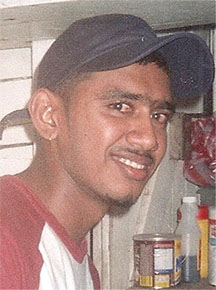State Prosecutor Judith Gildharie-Mursalin told the court on Friday how three coastguard officers threw Bartica gold dealer Dweive Kant Ramdass overboard after taking the $17 million he had in his possession, in her opening statement as the trial began.
The trial proper began at the High Court sitting at Suddie after Justice Franklyn Holder concluded the last voir dire (trial within a trial) that was being held to determine the admissibility of the statements of the three accused–Sherwyn Hart, Deon Greenidge and Delon Gordon–to the police.
Justice Holder ruled on the last voir dire by admitting the caution statement of the third accused Greenidge. The statements of Gordon and Hart were also admitted at the end of their voir dire and can be tendered as evidence by the prosecution represented by Judith Gildharie-Mursalin.

At Friday’s session, the prosecution made its opening address to the court after which the brother of the deceased, Stephen Persaud, testified. Persaud’s evidence was based on the fact that he identified his brother’s body.
The three former Guyana Defence Force Coastguards are accused of killing Ramdass between August 20 and 22, 2009 at Caiman Hole, East Bank Essequibo and are represented by attorney Peter Hugh.
In her opening address to the judge and jury, Gildharie-Mursalin said that Hart, Gordon and Greenidge, were coastguards stationed at Fort Island in the Essequibo River.
On August 20, Ramdass, who lived at Third Avenue, Bartica, was at Parika where he met Kerwain Chance called `Wild Cow’ and Paul Eastman. Ramdass handed over a quantity of gold he had in a haversack to Chance and Eastman and collected a carton box containing some $17 million, Gildharie-Mursalin said.
She added that the exchange between the men took place at the junction at Parika, after which Chance and Eastman dropped Ramdass off at the Parika Stelling where they saw him walk down the passageway leading to the speedboats.
At about 3.30 pm the same day, Gildharie-Mursalin stated, Hart, Gordon and Greenidge dressed in their uniforms, were working river patrol with the coastguard boat. They had an M70 rifle with 90 rounds of ammunition in their possession.
Gildharie-Mursalin said that Hart subsequently received certain information via his cell phone pertaining to a male East Indian wearing sunglasses and carrying a carton. As a result they began stopping speedboats heading to Bartica in search of the man. Hart did not see the man he was looking for and as such they headed to the Parika Stelling where a man matching the description was standing on the beach with a carton next to him. That man was Ramdass.
Hart went up to Ramdass and asked him what he had in the box and Ramdass told him he had $17 million, she said. Upon hearing this, Hart told Ramdass that he had to arrest him and took him to the coastguard boat along with his box containing the money.
Albert Knights called “Tony” and a taxi driver, Leonard Brotherson called “Tucker” saw when Ramdass left with the three accused. “Tucker,” who knew Ramdass’s family, immediately contacted his brother Persaud.
Gildharie-Mursalin said the three accused took Ramdass to Caiman Hole where Hart instructed him to take off his clothes leaving him with his boxer shorts.
Greenidge then opened the carton and verified to Hart that the box had money. Ramdass was then thrown overboard and left there while the accused drove off in their boat with his cash.
They then went to the coastguard base where they split the $17 million among themselves and then headed back to Parika where Hart called his brother and told him to meet him at Parika with a taxi.
The prosecutor said that Gordon on the other hand called his sister to collect his share of the cash while Greenidge called his mother and told her to go to Parika. They handed over the cash to their respective relatives.
The mother was subsequently arrested at Parika with over $5 million and the three accused were taken into custody the same evening, Gildharie-Mursalin said.
They also gave statements to the police in which they admitted to taking Ramdass to Caiman Hole and throwing him overboard before taking away his cash. They also took police officers to the location where they committed the act. Ramdass’s body was found by a farmer on August 22, 2009, floating in the Essequibo River.
The trial will continue Tuesday with more prosecution witnesses testifying.




